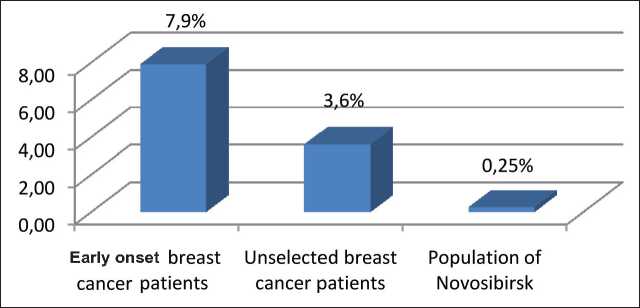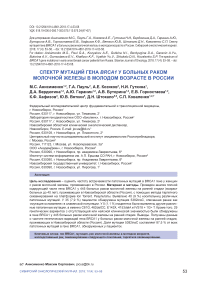The spectrum of BRCA1 gene mutations in early onset breast cancer patients from Russia
Автор: Anisimenko M.S., Paul G.A., Kozyakov A.E., Gutkina N.I., Berdyugina D.A., Garanin A.Yu., Butorina A.V., Gornostaeva E.V., Khafizov K.F., Vyatkin Yu.V., Shtokalo D.N., Kovalenko S.P.
Журнал: Сибирский онкологический журнал @siboncoj
Рубрика: Клинические исследования
Статья в выпуске: 4 т.17, 2018 года.
Бесплатный доступ
Aim of the study. Aim of the study was to estimate the occurrence of pathogenic mutations in the BRCA1 gene in Russian breast cancer patients. material and methods. Complete coding sequence of the BRCA1 gene of 445 early onset breast cancer patients (under 40 years) from Novosibirsk region (Russia) were analyzed by targeted Next generation Sequencing (NgS) using Ion Torrent platform. results. Forty (9%) carriers of various pathogenic mutations were revealed. Thirty five (7,9%) patients carried 5382insC mutation, described earlier as a founder mutation for Slavic population. Five (1.1%) patients carried various pathogenic mutations, namely C61g, 462delCC, E143x, 4153delA, and IVS18+1g>T. besides, 29 genetic variants with no clinical significance or with unknown clinical significance were detected in BRCA1 gene among 445 early-onset breast cancer patients. Conclusions. Data on the frequency of genetic variations in the BRCA1 gene among early-onset breast cancer patients in the Novosibirsk Region (Russia) were obtained. Proportion of the 5382insC mutation is 87.5% of all pathogenic mutations in the BRCA1 gene found in patients.
Brca1 gene, mutation, early-onset breast cancer, hereditary cancer, ngs, targeted sequencing
Короткий адрес: https://sciup.org/140254200
IDR: 140254200 | УДК: 618.19-006.6-056.7-053:575.113:575.24(47+57) | DOI: 10.21294/1814-4861-2018-17-4-53-58
Текст научной статьи The spectrum of BRCA1 gene mutations in early onset breast cancer patients from Russia
Hereditary factors account for up to 10% of all breast cancer cases [1]. A significant part of the hereditary forms of breast cancer is caused by mutations in the BRCA1 and BRCA2 genes. The likelihood of a malignancy during the lifespan for BRCA1/2 mutation carriers is very high (up to 90%) [2].
Several studies demonstrated the prevalence of BRCA1 5382insC mutation among breast/ovarian cancer patients in Russia [3–5]. Frequency of 185delAG, C61G, and 4153delA mutations is significantly less compared to 5382insC, the frequency of other mutations in BRCA1 gene remains unexplored [6, 7]. However, there are no exact figures regarding frequency of BRCA1 mutation in Russian population and among cancer patients, these data can be useful for screening programs and/or for placing objectives on the mutation analysis guidelines. According to our previous results, population study can reveal only frequent mutations (as BRCA1 5382insC), only single cases of other frequent mutations can be
Early onset cancer patient’s cohort contains increased proportion of hereditary cancer cases, so analysis of this group can provide information on the spectrum and frequencies of pathogenic mutations in population. This information can be of value for the guidelines for the analysis of mutations among Russian citizens. In this study, we analyzed a complete coding sequence of BRCA1 gene of 445 early onset breast cancer patients from Novosibirsk region with the aim to estimate the occurrence of pathologic mutations in the BRCA1 gene in Russia.
Material and Methods
Blood samples were collected from 445 breast cancer patients of the Novosibirsk Regional Oncology Clinic between April 2013 and June 2016. The age of the patients at the time of diagnosis was from 19 to 40 years.
DNA was isolated from the blood samples using RealBest extraction 100 Kit (Vector-Best, Russia).
Analysis of the complete coding sequence of the

Figure 1. Frequency of the BRCA1 5382insC mutation in early onset breast cancer patients, unselected breast cancer patients, and in general population of Novosibirsk city
BRCA1 gene (22 exons, 5592 bp) was performed by targeted sequencing on IonTorrent platform. All exons with adjacent intron regions (20–80 bp) were completely covered with 68 amplicons (140–190 bp). Primers were designed by using Ion AmpliSeq Designer and Primer 3 software. The primer pairs were combined into 3 pools. Three multiplex PCR reactions were used to amplify the 68 selected fragments. Multiplex reaction products were combined and purified using Agencourt AMPure XP magnetic beads (Beckman Coulter, USA). The amplicons were ligated with bar codes and A/P1 adapters. Then enrichment was carried out with the primer pair complementary to adapters A and P1. Concentration of the purified enriched amplicons was measured using Qubit dsDNA HS Assay kit on the Qubit 3.0 fluorimeter (Life Technologies, USA). The normalized DNA libraries were then amplified by emulsion PCR using Ion PGM Hi-Q OT2 kit and sequenced using Ion PGM instrument (Life Technologies, USA) according to the manufacturer’s instructions.
Bioinformatic analysis of the raw data was based on PRINSEQ technique [9]. The nucleotide sequences obtained in the analysis were compared with the reference sequence of the human genome GRCh37/ hg19 using the BWA-MEM software version 0.7.5 [10]. The search for genetic variants was carried out using the SAM tools software version 0.1.19 [11].
Results and discussion
Analysis of 445 early onset breast cancer patients revealed 35 genetic variants in BRCA1 gene. Results of the study are presented in Table 1.
We detected 40 carriers (9%) of various pathogenic mutations, including 35 carriers (7.9%) of 5382insC mutation. BRCA1 5382 insC was described as founder mutation for Slavic population [5]. Five patients (1.1%) carried pathogenic mutations C61G, 462delCC, E143X, 4153delA, and IVS18+1G>T (each particular mutation was found in a single patient in a heterozygote state). All pathogenic mutations are depicted in bold in Table 1. According to our previous results, the frequency of the 5382insC mutation among residents of Novosibirsk city is 0.25% [8], the frequency of this mutation among unselected breast cancer patients in the Novosibirsk region is 3.6% [12]. Figure 1 shows the frequency of the 5382insC mutation among unselected breast cancer patients and in the cohort of early onset breast cancer patients in comparison with the frequency of this mutation in general population.
Remarkably, allele frequency of 9 genetic variants is at least twice higher than the frequency provided in the database for general population (ExAC or/and 1000 genomes), these variants are marked in italics in Table 1.
The frequency of three genetic variants has not assigned in dbSNP yet and are not specified in Table 1. Two of these variants were undisclosed for the first time. Ermolenko N.A. et al. found the 462delCC (p.Pro115Terfs) mutation in Russian breast cancer patients [13].
The obtained data on BRCA1 mutation frequencies can be the basis for the guidelines for mutation analysis in various cohort of breast cancer patients (patients with family history, early onset breast cancer patients etc.). Indeed, our data indicate the absence of hot-spot mutation except BRCA1 5382insC, but a very strong prevalence of this mutation in early onset cancer patients (87.5 % of all found BRCA1 mutations). A frequency of the BRCA1 5382insC mutation among non-selected breast cancer patients in Russia was reported in several studies [4, 12, 14]. Similar frequency of the BRCA1 5382insC mutation was reported for Ukranian breast cancer patients [15].
In spite of the high frequency of the BRCA1 5382insC mutation among unselected cancer patients in Poland [16] the mutation occurrence is more than two times less than in Russia (1.9 %) and just slightly higher than the frequency of the mutation C61G (1.2 %). A frequency of BRCA1 5382insC mutation in Germany among unselected breast cancer patients is even less (1%) [17].
Thus, the frequency of the BRCA1 5382C mutation among unselected breast cancer patients from Europe is maximal in Russia (3.6–4 %), intermediate in Poland and Germany (1.9 % and 1.0 %, correspondingly) and quite rare in France [18] and in Spain [19].
So, this data leads to the logical considerations regarding the workflow of the BRCA1 gene mutations analysis specifically for Russia. The frequencies of BRCA1 gene mutations in Russia dictates the need to analyze BRCA1 5382insC mutation as the first step of analysis and, if not found, to analyze a complete coding region of BRCA1 gene. This workflow is in contrast with the accepted idea to analyze 4–8 mutations which were ever found in cancer patients with family history. Moreover, due to the low cost and relative simplicity analysis of the BRCA1 5382insC mutation can be offered to all breast cancer patients with and without family history since a number of publications demonstrate a limited significance of family history in the present study.
Список литературы The spectrum of BRCA1 gene mutations in early onset breast cancer patients from Russia
- Mavaddat N., Antoniou A.C., Easton D.F., Garcia-Closas M. Genetic susceptibility to breast cancer. Mol Oncol. 2010 Jun; 4(3): 174-91. DOI: 10.1016/j.molonc.2010.04.011
- Fischer C., Kuchenbäcker K., Engel C., Zachariae S., Rhiem K., Meindl A., Rahner N., Dikow N., Plendl H., Debatin I., Grimm T., Gadzicki D., Flöttmann R., Horvath J., Schröck E., Stock F., Schäfer D., Schwaab I., Kartsonaki C., Mavaddat N., Schlegelberger B., Antoniou A.C., Schmutzler R. German Consortium for Hereditary Breast and Ovarian Cancer. Evaluating the performance of the breast cancer genetic risk models BOADICEA, IBIS, BRCAPRO and Claus for predicting BRCA1/2 mutation carrier probabilities: a study based on 7352 families from the German Hereditary Breast and Ovarian Cancer Consortium. J Med Genet. 2013 Jun; 50(6): 360-7. DOI: 10.1136/jmedgenet-2012-101415
- Gayther S.A., Harrington P., Russell P., Kharkevich G., Garkavtseva R.F., Ponder B.A.J. Frequently occurring germ-line mutations of the BRCA1 gene in ovarian cancer families from Russia. Am J Hum Genet. 1997 May; 60(5): 1239-42.
- Sokolenko A.P., Mitiushkina N.V., Buslov K.G., Bit-Sava E.M., Iyevleva A.G., Chekmariova E.V., Kuligina E.Sh., Ulibina Y.M., Rozanov M.E., Suspitsin E.N., Matsko D.E., Chagunava O.L., Trofimov D.Y., Devilee P., Cornelisse C., Togo A.V., Semiglazov V.F., Imyanitov E.N. High frequency of BRCA1 5382insC mutation in Russian breast cancer patients. Eur J Cancer. 2006 Jul; 42(10): 1380-84. DOI: 10.1016/j.ejca.2006.01.050
- Sokolenko A.P., Rozanov M.E., Mitiushkina N.V., Sherina N.Y., Iyevleva A.G., Chekmariova E.V., Buslov K.G., Shilov E.S., Togo A.V., Bit-Sava E.M., Voskresenskiy D.A., Chagunava O.L., Devilee P., Cornelisse C., Semiglazov V.F., Imyanitov E.N. Founder mutations in early-onset, familial and bilateral breast cancer patients from Russia. Familial Cancer. 2007; 6(3): 281-6. DOI: 10.1007/s10689-007-9120-5


